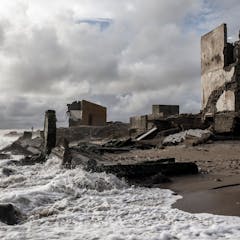
Articles on Sand
Displaying 1 - 20 of 26 articles

Not all types of ground are the same and understanding how varied ground types react to environmental stresses is key to achieving true sustainability.

Dunes can preserve a record of historic climate changes and shifting continents.

Rock dust is only part of the story of soil. Living creatures, many of them too tiny to see, keep that soil healthy for growing everything from food to forests.

With smartphones as commonplace as towels and sunscreen in the beach bag, why not add coastal data collection to your list of holiday activities this summer? Look for the CoastSnap camera cradles.

Building a sandcastle is a response to the full beach environment as a collaborator.

The international quest for green energy is reliant on ‘sacrificial zones’ in developing countries.

Sea glass, while an eye-catching treasure and a multimillion-dollar industry, exists because of decades of improper waste management.

Ammoglyphs – ancient ‘sand art’ – are a relatively new find.

Sand is an excellent material to play with. It is versatile, widely available, open-ended and cheap. And you don’t need a fancy plastic mould to make something special.

Establishing the age of K'gari (Fraser Island) confirms it emerged before the reef, despite the climate being suitable for coral growth long before then.

The energy-intensive process of producing cement and concrete contributes significantly to global warming while depleting resources. Much more sustainable alternatives are being developed.

From capillary forces to sand grain shape, the simple mix of sand and water hides the complexity within.

Coastal erosion in West Africa is a cause for global concern. The global community must rally to address climate change which is causing the retreat.

A trip to the beach is a perfect opportunity to explore the peculiar properties of some fascinating fluids.

A trip to the beach is off limits for some people with a disability. We need to change that, and the law supports it.

Over the past six months, tourists and locals have been shocked to see Byron’s famous Main Beach literally disappearing. Satellite imagery and local knowledge has revealed what’s going on.

As sand markets boom, entrepreneurs, organized crime and others are cashing in — leaving widespread environmental damage in their wake.

Sandy beaches are densely populated and occupy more than one third of the global coastline.

Sand may seem abundant when your toes are buried in it, but it’s becoming scarce along many coastlines around the world.

Given that we know humans moved across these landscapes, we wondered whether there might also be evidence of other forms of human activity on these surfaces of sand.
